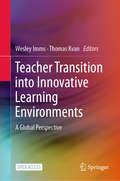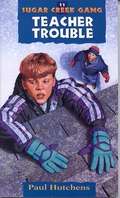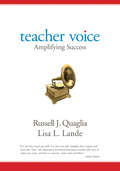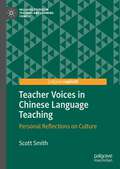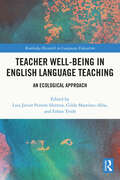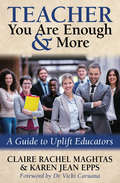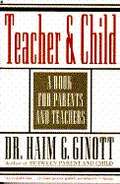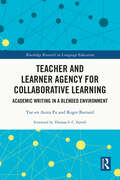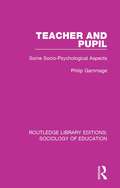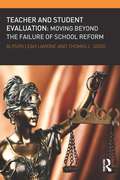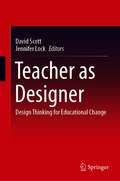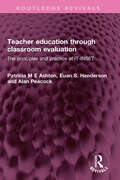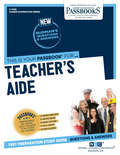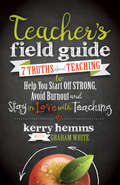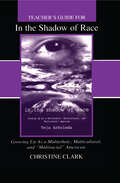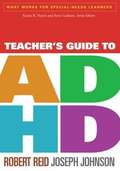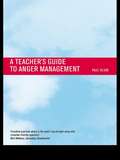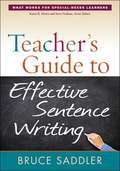- Table View
- List View
Teacher Transition into Innovative Learning Environments: A Global Perspective
by Thomas Kvan Wesley ImmsThis open access book focuses on how the design and use of innovative learning environments can evolve as teaching practices and education policies change. It addresses how these new environments are used, how teachers are adapting their practices, the challenges that these changes pose, and the effective evaluation of these changes. The book reports on emerging research in learning environments, with a particular emphasis on how teachers are transitioning from traditional classrooms to innovative learning environments. It offers a significant evidence-based global assessment of current research in this field by designers, architects, educators and policy makers. It presents twenty-five cutting-edge projects from researchers in fifteen countries. Thanks to the book’s comprehensive international perspective, which combines theory and practice in a single publication, readers will gain a wealth of new insights.
Teacher Trouble (Sugar Creek Gang #11)
by Paul HutchensThe Sugar Creek Gang continues to struggle with their new teacher, Mr. Black. They cause some of the trouble themselves when they build a snowman that looks a lot like him and he stumbles across it. Then someone outside the gang tries to frame the Sugar Creek Gang by putting a board over the chimney at school. Learn important lessons about honesty and respect with the Sugar Creek Gang. The Sugar Creek Gang series chronicles the faith-building adventures of a group of fun-loving. courageous Christian boys. These classic stories have been inspiring children to grow in their faith for more than five decades. More than three million copies later, children continue to grow up relating to members of the gang as they struggle with the application of their Christian faith to the adventure of life. Now that these stories have been updated for a new generation, you and your child can join in the Sugar Creek excitement. Paul Hutchens's memories of childhood adventures around the fishing hole, the swimming hole, the island, and the woods that surround Indiana's Sugar Creek inspired these beloved tales.
Teacher Voice: Amplifying Success
by Russell J. Quaglia Lisa L. LandeHelp teachers listen, learn, and lead for powerful school reform! Teacher insight and experience is a powerful yet underutilized resource in education, especially in these days of the new ESSA. Help teachers find their voice and positively influence their school’s learning environment with this inspiring guide. Student aspirations pioneer, Russell Quaglia, helps you expertly facilitate the process. Using the author’s three-part School Voice Model, you’ll discover in-depth action steps to help you incorporate teacher voice that has to be heard to sustain change. With Quaglia and Lande’s clear, step-by-step guidance, teacher interviews, reflections, and expert research, you’ll help teachers: Work collaboratively for school change Inspire and positively affect education stakeholders Effectively express themselves Build self-worth and realize their potential Increase engagement and define a sense of purpose Amplify their voice via technology Bolster teacher leadership and improve retention, innovation, professional development, and student achievement with this breakthrough guide! "In this innovative book, Russell Quaglia and Lisa Lande sets out how we can change that and how the voice of teachers can serve to systematically advance the knowledge-base of the profession and establish opportunities for exchange, collaboration and support. In today’s world, even the best Minister of Education can no longer solve the challenges of millions of teachers. But if we can capitalise on the expertise of millions of teachers, we can create the world’s best school system." Andreas Schleicher OECD "Quaglia and Lande have produced a treasure trove of new and high leverage ideas. Teachers Voice contains two powerful messages. One is that teacher voice contains the seeds of widespread transformation of learning. The other main message, alas, is that teacher voice is vastly under utilized---and teachers know it! This book is a call and guide to action to leverage a resource that is under our noses. Read it and act." Michael Fullan, Professor Emeritus University of Toronto "Teaching and fishing? Only a couple very imaginative educators would pair these two topics in a book. But that is just what Russell Quaglia and Lisa Lande have done, and that is just what they are—imaginative, optimistic, and deep-thinking educators. Their triadic epigram—Listen, Learn, Lead—would have saved many a frustrated school administrator who thought they should start with ′lead.′ This book is chock-full of sound advice, practical ideas, and voices of teachers, all describing how teachers work together and communicate with each other, with students, and with parents. Who, other than teachers, deserves a more prominent, yes central, role in any discussion of how schools improve. This is a delightful read that makes a less-imaginative educator want to get up in the morning and go to work. Or go fishing." Dr. Sam Redding, Executive Director Academic Development Institute
Teacher Voice: Amplifying Success
by Russell J. Quaglia Lisa L. LandeHelp teachers listen, learn, and lead for powerful school reform! Teacher insight and experience is a powerful yet underutilized resource in education, especially in these days of the new ESSA. Help teachers find their voice and positively influence their school’s learning environment with this inspiring guide. Student aspirations pioneer, Russell Quaglia, helps you expertly facilitate the process. Using the author’s three-part School Voice Model, you’ll discover in-depth action steps to help you incorporate teacher voice that has to be heard to sustain change. With Quaglia and Lande’s clear, step-by-step guidance, teacher interviews, reflections, and expert research, you’ll help teachers: Work collaboratively for school change Inspire and positively affect education stakeholders Effectively express themselves Build self-worth and realize their potential Increase engagement and define a sense of purpose Amplify their voice via technology Bolster teacher leadership and improve retention, innovation, professional development, and student achievement with this breakthrough guide! "In this innovative book, Russell Quaglia and Lisa Lande sets out how we can change that and how the voice of teachers can serve to systematically advance the knowledge-base of the profession and establish opportunities for exchange, collaboration and support. In today’s world, even the best Minister of Education can no longer solve the challenges of millions of teachers. But if we can capitalise on the expertise of millions of teachers, we can create the world’s best school system." Andreas Schleicher OECD "Quaglia and Lande have produced a treasure trove of new and high leverage ideas. Teachers Voice contains two powerful messages. One is that teacher voice contains the seeds of widespread transformation of learning. The other main message, alas, is that teacher voice is vastly under utilized---and teachers know it! This book is a call and guide to action to leverage a resource that is under our noses. Read it and act." Michael Fullan, Professor Emeritus University of Toronto "Teaching and fishing? Only a couple very imaginative educators would pair these two topics in a book. But that is just what Russell Quaglia and Lisa Lande have done, and that is just what they are—imaginative, optimistic, and deep-thinking educators. Their triadic epigram—Listen, Learn, Lead—would have saved many a frustrated school administrator who thought they should start with ′lead.′ This book is chock-full of sound advice, practical ideas, and voices of teachers, all describing how teachers work together and communicate with each other, with students, and with parents. Who, other than teachers, deserves a more prominent, yes central, role in any discussion of how schools improve. This is a delightful read that makes a less-imaginative educator want to get up in the morning and go to work. Or go fishing." Dr. Sam Redding, Executive Director Academic Development Institute
Teacher Voices in Chinese Language Teaching: Personal Reflections on Culture (Palgrave Studies in Teaching and Learning Chinese)
by Scott SmithThis book reports the results of an ethnographic study, focusing primarily on the experiences of four teachers of the Chinese language in Australian secondary schools. The author creates an audience for their voices as they reflect on their own understandings of culture, language teaching, and culture in language teaching through semi-structured interviews, and compares these reflections with written stimulus dialogues designed to elicit 'culture-in-language' reflections, as well as curriculum and policy documents produced by the Australian government. The book's findings indicate that teachers of the Chinese language are diverse in their views on culture, language teaching, and the ways in which culture can or should inform language teaching, and the author argues that language teacher intercultural competence cannot be assessed through a synthesis of the current English-only research literature. This book will be of interest to teachers and teacher trainers of Chinese as a foreign language, as well as students and scholars of applied linguistics and language education more broadly.
Teacher Well-Being in English Language Teaching: An Ecological Approach (Routledge Research in Language Education)
by Luis Javier Pentón Herrera Gilda Martínez-Alba Ethan TrinhThis edited volume brings the important topic of teacher well-being to the fore, presenting a range of high quality and cutting-edge contributions that illuminate, advance and educate readers on the challenges and criticality of achieving teacher well-being in English language teaching (ELT). Taking Sarah Mercer’s call for action to make teacher well-being a priority in the ELT field, and adopting an ecological perspective reflective of the stance that teacher well-being is a societal duty and not a personal responsibility, the contributors present theoretically and methodologically innovative research studies from all around the world. The term ‘teacher’ is used to refer to those who deliver English instruction in a variety of formal and informal educational settings and at different levels including K-12 schools, adult education, higher education, teacher education programs, and in community organizations. Chapters offer clear implications for research and practice, and explore effective practices and interventions that can contribute to the improvement of teacher well-being overall. Addressing a profession which is not only characterized as being filled with high levels of stress, but delving into specific challenges around ELT in particular, the authors crucially speak to themes around the additional emotional investment and labor which come with being an English language teacher. As such, it will appeal to academics and researchers in the field of English language teaching, including scholar-practitioners, and teacher educators.
Teacher Well-Being: Looking After Yourself and Your Career in the Classroom
by Elizabeth HolmesAll teachers experience negative stress in the workplace whether it is due to pressures of the job whilst at school or the perpetual need to take work home. In this informative book, Elizabeth Holmes provides practical advice and solutions to enable teachers to experience less negative stress in their lives and understand the links between the way they function in the classroom and their personal well-being. Drawing on real life case studies and providing strategies for teachers wanting to be proactive in dealing with their well-being, stress and career, this book outlines all the different components that contribute to physical, emotional, spiritual and mental well-being. This includes: * good stress and bad stress* communication* enhancing personal well-being at school* well-being and career development. Written in a clear and accessible style with plenty of practical examples and advice, Teacher Well-Being is an essential read for all teachers, headteachers and school managers, whether just entering the profession or experienced practitioners.
Teacher You Are Enough & More: A Guide to Uplift Educators
by Claire Rachel Maghtas Karen Jean EppsInspiration for those working in education—to prevent burnout, persevere through challenges, and keep their spirit strong! This book supports and uplifts those who have devoted themselves to the demanding, difficult, and often underappreciated work of education—offering strategies, exercises, and tools that align teachers&’ spirits with God to stay at peace while teaching. Educators Claire Rachel Maghtas and Karen Jean Epps&’ intention is to energize other educators and give them useful techniques for handling stress and persevering through the difficult times. This inspirational guide includes invigorating verses from the Bible along with personal testimonies to help teachers cope. Teachers will learn strategies to stay in balance while enhancing students&’ achievements and well-being.
Teacher and Child: A Book for Parents and Teachers
by Haim G. GinottGives both the teachers and parents an insight to psychological problem children encounter in everyday situation.
Teacher and Learner Agency for Collaborative Learning: Academic Writing in a Blended Environment (Routledge Research in Language Education)
by Yue-en Anita Pu Roger BarnardThis book offers educators practical strategies to cultivate agency in both teachers and learners. By focusing on collaborative learning through writing, blended learning and reflective practice, it equips readers with essential tools to enhance their teaching methods and promote learner autonomy in various educational contexts.Blending theory with real-world applications, the book demonstrates how learner and teacher agency are deeply interconnected, showing how collaboration, technology and reflective practices create more dynamic, student-centred classrooms. The first author’s action research project provides practical insights, illustrating how agency can be fostered in both in-person and blended learning environments. Readers will also gain valuable perspectives from other teachers, who share how reflective practice has helped them improve their own agency, as well as their students’ engagement and independence.Educators, teacher educators and researchers across disciplines will find this book indispensable for its evidence-based strategies, offering actionable approaches to fostering agency, collaboration and professional development in today’s rapidly evolving educational landscape.
Teacher and Pupil: Some Socio-Psychological Aspects (Routledge Library Editions: Sociology of Education #26)
by Philip GammageThis title, first published in 1971, provides a guide to the social psychology of learning. The author examines the school class as a group and considers the formation of some of the attitudes of the children and the teacher as they relate to education. Building upon interaction as a major theme, the study focuses attention on the ways in which relationships can affect the classroom climate. The background to group dynamics leads to the elements of sociometry and to consideration of teaching styles, communication structure and perceptions of the teacher’s role. This title will be of interest to students of sociology and education.
Teacher and Student Evaluation: Moving Beyond the Failure of School Reform
by Thomas L. Good Alyson Leah LavigneFollowing the recent major school reform of Race to the Top, schools, teachers, and students are increasingly evaluated through high-stakes achievement test scores. In six concise chapters, Teacher and Student Evaluation explores the historical rise and modern landscape of accountability in American education, and the current models of teacher evaluation. The authors provide realistic and useful suggestions for responding to current accountability demands. The authors explore the methodological concerns and policy implications of using value-added and observational measures to make high-stakes decisions. After reaching the conclusion that these contemporary evaluation practices are flawed, Alyson Lavigne and Thomas Good offer possible solutions that inform current and future teacher evaluation. This book is a valuable resource for students of educational assessment as well as policy makers, administrators, and teachers who are currently building accountability plans. The book is written in an accessible but authoritative fashion that practitioners, policymakers, and scholars will find useful.
Teacher as Activator of Learning
by Gayle H. GregoryFlip the Switch! How to Get Students Into Learning Mode Now. In his well-known meta-analysis, John Hattie suggests that facilitating learning is not as effective or powerful as activating learning. In this book Gayle Gregory shows you how to facilitate better and deeper learning. Packed with practical strategies that teachers can use every day to increase student achievement, you will also discover what educational neuroscience says about nurturing a "growth mindset" and creating classrooms that support and encourage students to take risks and "fail forward." Learn how to Foster student dialogue and thinking Orchestrate productive, reflective flexible student groups Develop respectful learning relationships between and among students and teachers Teacher competencies and clarity related to student goals and success criteria, with quality feedback, are essential for student success. This resource will enrich learning environments for students and increase the chance of success for all. "In going from ‘teachers as fount of knowledge’ to ′teacher as facilitator’ the field has overcorrected. Gayle Gregory corrects all that with a comprehensive and deep portrayal of the need for ’teachers to be activators’ of learning in partnership with students. Based on equal measure of research and practice Gregory gives is a compelling set of ideas and tools to maximize student learning and engagement. Read it and hit the ground running!" Michael Fullan, Professor Emeritus, OISE/University of Toronto
Teacher as Activator of Learning
by Gayle H. GregoryFlip the Switch! How to Get Students Into Learning Mode Now. In his well-known meta-analysis, John Hattie suggests that facilitating learning is not as effective or powerful as activating learning. In this book Gayle Gregory shows you how to facilitate better and deeper learning. Packed with practical strategies that teachers can use every day to increase student achievement, you will also discover what educational neuroscience says about nurturing a "growth mindset" and creating classrooms that support and encourage students to take risks and "fail forward." Learn how to Foster student dialogue and thinking Orchestrate productive, reflective flexible student groups Develop respectful learning relationships between and among students and teachers Teacher competencies and clarity related to student goals and success criteria, with quality feedback, are essential for student success. This resource will enrich learning environments for students and increase the chance of success for all. "In going from ‘teachers as fount of knowledge’ to ′teacher as facilitator’ the field has overcorrected. Gayle Gregory corrects all that with a comprehensive and deep portrayal of the need for ’teachers to be activators’ of learning in partnership with students. Based on equal measure of research and practice Gregory gives is a compelling set of ideas and tools to maximize student learning and engagement. Read it and hit the ground running!" Michael Fullan, Professor Emeritus, OISE/University of Toronto
Teacher as Designer: Design Thinking for Educational Change
by David Scott Jennifer LockThis book offers insights into how design-based processes, principles, and mindsets can be productively employed in diverse P-16 educational spaces by a myriad of educational actors including teachers, instructional leaders, and students. It addresses concerns about the theoretical and practical implications of the still emergent emphasis of design in education. The book begins by examining a number of prominent design processes being used by educators including human-centred design, designing for authentic inquiries, and Universal Design for Learning. It then delves into how teachers, system leaders, and students can engage in educational design within the complex spaces of K-12 contexts. Finally, the book takes up design in education within a maker and making context. Each chapter includes a vignette, a series of guiding questions, along with specific design principles that can help address common challenges and issues educators encounter in their practice. This book provides both theoretical and practical elements involved in educational design and is beneficial to scholars, graduate students, educators, and pre-service teachers.
Teacher at Point Blank: Confronting Sexuality, Violence, and Secrets in a Suburban School
by Jo Scott-CoeWhy would a high school teacher who loves teaching leave school—after half a career in the classroom? Teacher at Point Blank answers this question at a time when concerns about school performance, safety, and teacher attrition are at an all-time and often anxious high. Meditating on subtle and overt forms of violence in secondary public education from an up-close and “pink collar” point of view, Jo Scott-Coe examines her own workplace as a microcosm of the national compulsory K-12 system, where teachers—now nearly 80% women—find themselves idealized and disparaged, expected to embody the dedication of parents, the coldness of data managers, and the obedience of Stepford spouses. Haunted and compelled forward by memories of a classmate who commits suicide on campus, a former teacher-colleague who dies all alone, Hollywood fantasies of the “ideal teacher,” and chronic reports of school violence and increasing gender crime, Scott-Coe reveals how her hopes, past and present, struggle for breath at the point blank of denial, confinement, addiction, isolation, hostility, subliminal eroticism—and, at times, a healthy dose of fear. Jo Scott Coe's very fine memoir of her teaching life is unlike anything I have read before. Her lean prose is unyielding to sentimentality and aspires always toward honesty about our lives as adults and as children. One is, here, in the presence of a writer who convinces us that teaching young lives is a constant and, sometimes, terrible journey of adult self-discovery. —Richard Rodriguez, author of Brown: The Last Discovery of America This unique and daring book lifts the cheerful, can-do mask that hides the reality of what it means to be a teacher. In luminous prose, Jo Scott-Coe debunks the sentimentalized mystique, exposing the harsh reality of extreme expectations, isolation, and psychic disconnect that engulfs teachers' lives. Scott-Coe's truth is at once disturbing and emancipating. —Susan Ohanian, author of Why Is Corporate America Bashing Our Public Schools?Jo Scott-Coe writes with humor, insight, and a deep love for her subject. In many ways, she has become a voice for her generation and for teachers, too. Remarkable. —Chris Abani, author of GraceLand and The Virgin of Flames Why would a high school teacher who loves teaching leave school—after half a career in the classroom? Teacher at Point Blank answers this question at a time when concerns about school performance, safety, and teacher attrition are at an all-time and often anxious high. Meditating on subtle and overt forms of violence in secondary public education from an up-close and “pink collar” point of view, Jo Scott-Coe examines her own workplace as a microcosm of the national compulsory K-12 system, where teachers—now nearly 80% women—find themselves idealized and disparaged, expected to embody the dedication of parents, the coldness of data managers, and the obedience of Stepford spouses. Haunted and compelled forward by memories of a classmate who commits suicide on campus, a former teacher-colleague who dies all alone, Hollywood fantasies of the “ideal teacher,” and chronic reports of school violence and increasing gender crime, Scott-Coe reveals how her hopes, past and present, struggle for breath at the point blank of denial, confinement, addiction, isolation, hostility, subliminal eroticism—and, at times, a healthy dose of fear. Jo Scott Coe's very fine memoir of her teaching life is unlike anything I have read before. Her lean prose is unyielding to sentimentality and aspires always toward honesty about our lives as adults and as children. One is, here, in the presence of a writer who convinces us that teaching young lives is a constant and, sometimes, terrible journey of adult self-discovery. —Richard Rodriguez, author of Brown: The Last Discovery of America This unique and daring book lifts the cheerful, can-do mask that hides the reality of what it means to be a teacher. In luminous prose, Jo Scott-Coe debunks the sentimentalized mystique, exposing the harsh reality of extreme expectations, isolation, and ps
Teacher education through classroom evaluation: The principles and practice of IT-INSET (Routledge Revivals)
by Alan Peacock Euan S. Henderson Patricia M E AshtonFirst Published in 1989 Teacher education through classroom evaluation is about the IT- INSET (Initial Training- In-Service Education and Training) approach to improving children’s learning. It argues that continuous improvement depends upon the quality of teachers’ theorising about learning and teaching. With help of case studies, it discusses important themes like evaluation strategy; IT- INSET in practice; the benefits of IT- INSET; influence of training institutions; helping and hindering factors and the present and future of IT- INSET, to showcase that IT-INSET represents both a philosophy of teacher education and a school-based programme of collaborative evaluation. This book is a must read for scholars and researchers of education.
Teacher's Aide: Passbooks Study Guide (Career Examination Series)
by National Learning CorporationThe Teacher's Aide Passbook® prepares you for your test by allowing you to take practice exams in the subjects you need to study. It provides hundreds of questions and answers in the areas that will likely be covered on your upcoming exam, including but not limited to: reading comprehension; English usage, including vocabulary, grammar and spelling; spatial relationships; and more.
Teacher's Field Guide: 7 Truths About Teaching to Help You Start off Strong, Avoid Burnout, and Stay in Love with Teaching
by Graham White Kerry HemmsFifty percent of new teachers leave the profession within the first five years. Of those who stay, most go through periods of burnout.Teachers everywhere start with high hopes of making a difference, but quickly get consumed with all of the unexpected demands, leaving them exhausted and wondering if this whole teaching thing was a good idea. While there are many books focused on curriculum and teaching techniques, Teacher&’s Field Guide takes a unique approach by addressing the real-life needs of the teacher who is often left behind and rarely discussed by other books in the marketplace.Teacher&’s Field Guide is all about that &“other stuff&”. It offers tips, tools, and strategies to lessen the stress, and increase the joy in teaching.It supports each teacher in seven important areas of their personal and professional lives:Mindset ManagementClassroom ManagementWorkload ManagementPeople ManagementStress ManagementSelf ManagementBig Picture ManagementTeachers will discover answers to questions such as:How can I really make a difference when it&’s so stressful?What is the simplest and easiest classroom management plan that really works?How do I have a life outside of school when the workload never ends?What is the secret to having great relationships with students, parents, administrators, and colleagues?What&’s the deal with burnout? How do I know if I have it, and what should I do if it&’s there?Teachers matter, and teachers deserve to be supported and encouraged while they lead our future generations. Teacher&’s Field Guide is the personal support teachers everywhere have needed, and guarantees to help reverse the trend that 50% of new teachers quit within their first five years.
Teacher's Guide for in the Shadow of Race: Growing Up As a Multiethnic, Multicultural, and Multiracial American
by Christine Clark Teja ArboledaThis Teacher's Guide accompanies In the Shadow of Race: Growing Up as a Multiethnic, Multicultural, and "Multiracial" American by Teja Arboleda. It has a twofold purpose. First, it facilitates K-12 and university faculty in situating Arboleda's book within the fields of race relations, multicultural education, and related disciplines. Second, it is intended to critique and problematize the book's content so that it can be used to stimulate critical thought, debate, and action oriented toward increasing social justice among its readers both inside and outside of the classroom. To facilitate use of In the Shadow of Race as a course text, topics for discussion included in this Teacher's Guide include the social construction of race; racial separatism versus diversity; racial, ethnic, and cultural identity development; the politics of racial categorization; mixed "race" peoples; cultural identity vs. identity by heritage; the concept of a "cultural home"; and changing identities within cultures.The Teacher's Guide is free to college faculty who adopt Arboleda's In the Shadow of Race.
Teacher's Guide to ADHD
by Joseph Johnson Robert ReidMeeting a key need for teachers, this book provides practical, data-based tools for helping students with attention-deficit/hyperactivity disorder (ADHD) succeed in the classroom. The authors combine instructional expertise with extensive knowledge about the nature and treatment of ADHD. Coverage includes ways to support students and teach them needed strategies in core areas: academic skills, behavior, self-regulation, and social skills. Step-by-step instructions and concrete examples help teachers implement effective interventions and accommodations. The book also offers crucial guidance for teaming with other school professionals and with parents.
Teacher's Guide to Adapted Physical Education: Including Students with Disabilities in Sports and Recreation
by Martin E. BlockA healthy and active lifestyle for all students: That's the promise of physical education, and the goal of this comprehensive textbook. Now in a thoroughly updated fourth edition, this text prepares current and future PE teachers to lead welcoming, inclusive classes where every student participates, makes friends, and learns new skills and values. K - 12 physical educators will get cutting-edge research and guidance on inclusive education, concrete strategies for planning and implementing an adapted PE program, and valuable disability-specific information. An essential resource for preparing both general PE teachers and adapted PE teachers, this text will provide a solid foundation for gym classes that meet every student's needs. This new edition has: 9 chapters on teaching students with specific disabilities, making it an ideal text for APE courses; more student-friendly features including updated tips and reproducible forms for planning and teaching, chapter objectives, additional resources, and more case studies; and more photos and illustrations throughout the book to emphasize key points.
Teacher's Guide to Anger Management: Null
by Paul BlumAs schools are making efforts to include children with emotional and behavioural problems, teachers are having to deal with angry and violent pupils almost every day. Paul Blum's latest book offers a recognisable, blunt and truthful account of widespread and often quite horrendous problems affecting teachers today, and offers practical strategies and solutions. He provides basic day-to-day guidance as well as help for the longer term PSHE planning for schools, based on his own adaptation of the highly successful 'Everyman' project.Issues discussed include a practical survey for teachers on the types of incidents they have to deal with, where anger comes from, the problems that anger causes, and strategies which can be used to help individual pupils.A teacher's inability to deal with difficult pupils can affect their professional and personal life, as well as their ability to successfully teach all their pupils. This essential book offers guidance when they need it most, offering a life-line to teachers in difficult circumstances.
Teacher's Guide to Effective Sentence Writing
by Bruce SaddlerThis practical book provides explicit instructions for teaching sentence-level skills to students who have difficulties in this area. The author explains the key role of sentence combining in the writing process and presents effective techniques for instruction and assessment. Numerous sample lessons, practice activities, planning tips, and grammatical pointers make it easy for teachers to incorporate sentence combining and construction into the writing curriculum at all grade levels (2-12). Accessible and engaging, the book helps teachers and students experiment with different ways to arrange thoughts and produce meaningful written work.
Teacher's Guide to Using the Next Generation Science Standards With Gifted and Advanced Learners
by Cheryll M. Adams Alicia Cotabish Debbie DaileyA Teacher's Guide to Using the Next Generation Science Standards With Gifted and Advanced Learners provides teachers and administrators with practical examples of ways to build comprehensive, coherent, and rigorous science learning experiences for gifted and advanced students from kindergarten to high school. It provides an array of examples across the four domains of science: physical sciences; Earth and space sciences; life sciences; and engineering, technology, and applications of science. Each learning experience indicates the performance expectation addressed and includes a sequence of activities, implementation examples, connections to the CCSS-Math and CCSS-ELA, and formative assessments. Chapters on specific instructional and management strategies, assessment, and professional development suggestions for implementing the standards within the classroom will be helpful for both teachers and administrators.
